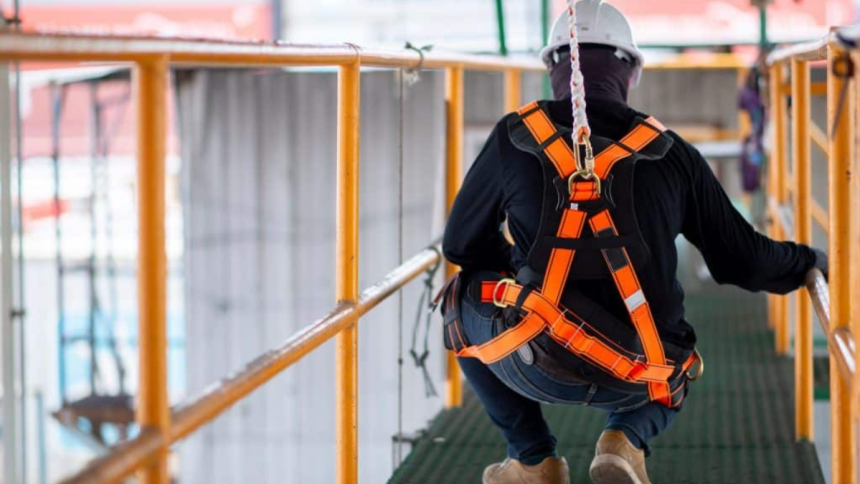Falls from height remain the leading cause of fatal injuries on UK construction sites. One loose ladder, one forgotten check or one moment of inattention can change lives in an instant.
Every construction site owner knows the dangers, but knowing is not enough. Action is needed every day, on every site, by every team.
Working at height safely is not about luck. It depends on good planning, the right equipment, proper training and a strong safety culture.
This article explains why height work is risky, what site owners must do, and how to get it right from the start.
Understanding the Risks of Working at Height
Height work is more common than many realise. It is not just scaffolders and steel workers who are exposed to risks, but also roofers, painters and electricians.
Anyone climbing a ladder, standing on a platform or reaching up high faces potential hazards. Falls cause more deaths and serious injuries than any other type of accident in construction.
However, it is not only falls that cause harm. Dropped tools, unsecured materials and bad weather all add extra risks to working at height.
Site owners must treat every height-related task seriously, whether it involves a tower crane or a small step ladder. Managing risks properly is the only way to keep workers safe.
Key Legal Duties for Site Owners and Contractors
Safety requirements for working at height are set by law. The Work at Height Regulations 2005 place clear duties on employers, site owners and contractors.
The first rule is simple: avoid working at height if it is possible to do so. Use equipment at ground level or find safer methods, such as extendable tools or prefabricated structures.
If working at height cannot be avoided, risks must be reduced through proper planning, safe equipment and supervision. Every task must be risk assessed, every worker must be competent and every piece of equipment must be safe.
Site owners must also check that contractors are properly trained and equipped. Failing to meet legal duties leads to enforcement action, financial penalties and increased risks on site. Encouraging staff to complete working at height training can give them an awareness of what risks to avoid and take necessary precautions.
Safe Planning Before Work at Height Starts
Rushing into height work without a plan is dangerous. Good planning makes all the difference and prevents mistakes before they happen.
Start with a site-specific risk assessment. Identify hazards such as fragile surfaces, overhead obstructions, unstable ground or adverse weather conditions.
Plan safe access routes, emergency rescue procedures and methods for carrying out tasks safely. For complex or high-risk jobs, create detailed method statements and share them with the whole team.
If anything changes during the job, such as weather conditions or access arrangements, stop work and reassess the plan. Good planning is not a delay; it is what keeps sites running safely.
Choosing the Right Access Equipment
Using the right equipment is critical for safe working at height. Scaffold towers are ideal for longer jobs, while Mobile Elevating Work Platforms (MEWPs) offer flexibility for changing tasks.
Rope access may be suitable for specialist tasks, but it requires proper planning and competent operators. Ladders should only be used for short, low-risk jobs where safer alternatives are not practical.
Equipment must be inspected carefully before every use. Missing parts, worn ropes or damaged harnesses must be dealt with immediately, not ignored.
Choosing safe equipment protects workers and prevents accidents. Cutting corners to save time is never worth the risk.
The Role of Workplace Training in Preventing Falls
Training is essential for building a safer approach to height work. Workers must know how to set up ladders, inspect harnesses, secure platforms and judge whether weather conditions are safe.
Good training creates real habits, such as stopping to check equipment and questioning anything that feels wrong. It also reminds workers that safety must come first, even on busy sites.
Refresher sessions play an important role because knowledge fades over time. Even simple reminders about correct ladder use can prevent serious accidents.
Completing workplace ladder safety training reinforces good habits and strengthens site culture. Training protects individuals and helps safeguard the entire site.
Common Mistakes and How to Avoid Them
Falls from height are often caused by small, repeated mistakes. Workers may rush to set up equipment, overreach from ladders or use damaged gear to save time.
Ignoring weather warnings, failing to secure ladders or leaving loose tools at height creates unnecessary risks. These small errors can quickly lead to serious incidents.
The solution lies in building better habits. Workers must be encouraged to stop, check, ask for help and fix problems before starting work.
Managers must set the right example through their own actions. Consistent attention to detail prevents small mistakes from turning into major accidents.
Best Practices for Managing Ongoing Work at Height
Safety must be maintained throughout the entire job, not just at the beginning. Daily checks and good communication keep risks under control.
Walk the site each morning, inspect equipment and review weather forecasts. Run toolbox talks if conditions change or new risks emerge.
Keep up regular inspections of all access equipment and replace damaged items immediately. Never allow broken gear to stay in use, even for one shift.
Update risk assessments if tasks or conditions change. Open communication means workers can speak up about concerns without fear, keeping everyone safer.
Final Takeaway
Working at height will always bring risks, but those risks can be managed properly. Good planning, smart equipment choices, proper training and strong daily habits are the foundation of safe construction sites.
Construction site owners shape the culture of their projects. They decide whether safety is treated as a daily habit or left as an afterthought.
The difference shows in every shift that ends without injury and every project completed safely. Building safe working at height practices is not about slowing down.
It is about making sure everyone gets home safely. That is what real success looks like.
Lynn Martelli is an editor at Readability. She received her MFA in Creative Writing from Antioch University and has worked as an editor for over 10 years. Lynn has edited a wide variety of books, including fiction, non-fiction, memoirs, and more. In her free time, Lynn enjoys reading, writing, and spending time with her family and friends.















